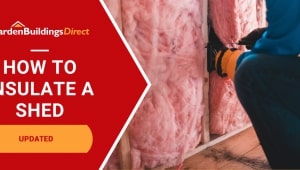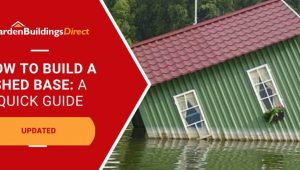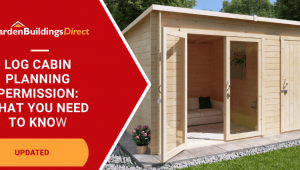Jump to:
Getting a new garden shed? You might have looked up a few tips online already or asked around. Some of them sound useful, others are a bit much, and then there are ones that, well, don’t help at all.
To make things easier, we’ve picked out some advice that often gets thrown around, and why it’s not always the best route. This might save you a few headaches down the line, so keep reading.
Don’t Fall For These Shed Myths!
These shared beliefs may sound convincing, but that’s not always true.
You can store just about anything in your shed
It often seems like a shed can hold pretty much anything. After all, it’s extra space, right? But some things are better left out.
Take food and groceries, for instance. Storing tins or pet food might seem handy, but it’s a magnet for pests like mice and rats. Not to mention the heat and damp that can spoil your cans over time. Non-perishable food in airtight containers should be fine, however.
The same goes for old gadgets or appliances like DVD players, fridges, or TVs. Moisture and temperature swings can ruin them, especially if the shed isn’t insulated.
If it does, plus with good ventilation, you might have more leeway. Even so, you’ll want to consider this before chucking everything in there. Better to be careful now than regret it later.
Skip the planning permission—sheds are an exception
You usually don’t need planning permission to put up a shed. They’re considered permitted development, but that doesn’t apply to every location. Rules can also vary depending on where you live. Double-checking with your local planning authority or LPA is always a good idea.
Here are some of the restrictions to keep in mind:
- The max height is 2.5m on the eaves and 4m overall (if it has a dual-pitched roof).
- It can’t go over 2.5m high if it’s within 2m of your boundary.
- No balconies, verandas, or raised platforms.
- The structure should be at least 5m from the house.
- You can’t put one in front of your home.
- Combined garden buildings shouldn’t take up more than half the land around your house.
- No using it as a self-contained living space or fitting it with an aerial.
- If your property’s listed, you’ll need full permission.
If you go ahead without checking and it turns out you’ve broken the rules, your council could step in. That might mean stopping the build, or worse, tearing it down.
Check out our guide to shed planning permission for the full details.
You can put your shed wherever you like
It’s your garden, so it’s only fair to have your storage building go anywhere, right? Well, not quite.
Stick it under a tree, and you’re setting yourself up for trouble. Leaves clog the roof, branches thud down in a storm, and tree sap will stick to it over the summer—it all adds up over time. You’ll spend more time cleaning or fixing it than using it.
Here’s where it gets real. Put it too close to your fence, and it might break local rules. Too far from the house, and you might never bother going out to it, especially in winter. Somewhere uneven or prone to flooding? Even worse.
Before you set it down, check the basics: Is the ground level? Can you get to it in a convenient way? Is it sheltered but not boxed in? Here’s a guide on things to consider when positioning your shed to learn more.
Shed maintenance is optional
Metal and plastic sheds are known for being low maintenance, and wood is the exact opposite. This depends, but overall, it’s really not.
With the kind of weather we get in the UK—wind, rain, snow—you can’t leave your shed to fend for itself. It doesn’t matter what it’s made from. Wood, metal, or plastic, all need to be looked after.
Otherwise, your garden storage will wear down, and whatever you’ve stored inside won’t be safe for long. Consider these for each shed type:
- Wooden sheds need treatment unless they’re pressure-treated. That extra step helps them handle the weather much better.
- Metal sheds are lower maintenance, but keep an eye on the gutters and clear out any muck. And make sure the galvanised coating doesn’t take any damage – this can lead to rust.
- Plastic sheds are pretty low-effort too, but make sure snow doesn’t pile up on the roof, as it can cause it to cave in. They shouldn’t be subjected to excessive weight-bearing.
A auick dust, sweep, and check for pests very few weeks can also go a long way!
You don’t need to wait for the ‘right’ season to purchase
Sure, spring and autumn might bring a few decent deals, but if you need a shed now, don’t hang about. There’s no rule saying you have to wait for a particular season.
The real question is whether you have the time to build it and know what you’re using it for. Ideally, you want a dry day to do the assembly.
Note: Your storage needs aren’t urgent, and you’re trying to save some money. In that case, waiting for off-season deals might be worth it. This guide can help: When Is the Best Time to Buy a Shed in the UK?
Sheds aren’t complicated, but the wrong advice can make them feel that way. Keep these points in mind when planning yours, and your shed will do exactly what you need it to.





